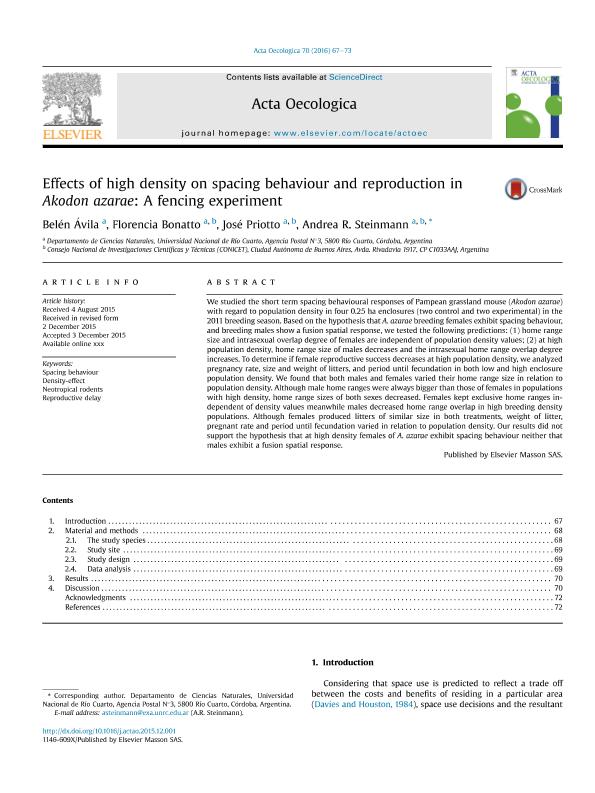Mostrar el registro sencillo del ítem
dc.contributor.author
Avila, Ana Belen

dc.contributor.author
Bonatto, Maria Florencia

dc.contributor.author
Priotto, Jose Waldemar

dc.contributor.author
Steinmann, Andrea Rosa

dc.date.available
2018-03-06T19:01:08Z
dc.date.issued
2016-01
dc.identifier.citation
Avila, Ana Belen; Bonatto, Maria Florencia; Priotto, Jose Waldemar; Steinmann, Andrea Rosa; Effects of high density on spacing behaviour and reproduction in Akodon azarae: A fencing experiment; Gauthier-villars/editions Elsevier; Acta Oecologica; 70; 1-2016; 67-73
dc.identifier.issn
1146-609X
dc.identifier.uri
http://hdl.handle.net/11336/38004
dc.description.abstract
We studied the short term spacing behavioural responses of Pampean grassland mouse (males exhibit a fusion spatial response.Akodon azarae) with regard to population density in four 0.25 ha enclosures (two control and two experimental) in the 2011 breeding season. Based on the hypothesis that A. azarae breeding females exhibit spacing behaviour, and breeding males show a fusion spatial response, we tested the following predictions: (1) home range size and intrasexual overlap degree of females are independent of population density values; (2) at high population density, home range size of males decreases and the intrasexual home range overlap degree increases. To determine if female reproductive success decreases at high population density, we analyzed pregnancy rate, size and weight of litters, and period until fecundation in both low and high enclosure population density. We found that both males and females varied their home range size in relation to population density. Although male home ranges were always bigger than those of females in populations with high density, home range sizes of both sexes decreased. Females kept exclusive home ranges independent of density values meanwhile males decreased home range overlap in high breeding density populations. Although females produced litters of similar size in both treatments, weight of litter, pregnant rate and period until fecundation varied in relation to population density. Our results did not support the hypothesis that at high density females of A. azarae exhibit spacing behaviour neither that males exhibit a fusion spatial response.
dc.format
application/pdf
dc.language.iso
eng
dc.publisher
Gauthier-villars/editions Elsevier

dc.rights
info:eu-repo/semantics/openAccess
dc.rights.uri
https://creativecommons.org/licenses/by-nc-sa/2.5/ar/
dc.subject
Density-Effect
dc.subject
Neotropical Rodents
dc.subject
Reproductive Delay
dc.subject
Spacing Behaviour
dc.subject.classification
Otras Ciencias Biológicas

dc.subject.classification
Ciencias Biológicas

dc.subject.classification
CIENCIAS NATURALES Y EXACTAS

dc.title
Effects of high density on spacing behaviour and reproduction in Akodon azarae: A fencing experiment
dc.type
info:eu-repo/semantics/article
dc.type
info:ar-repo/semantics/artículo
dc.type
info:eu-repo/semantics/publishedVersion
dc.date.updated
2018-03-05T20:43:17Z
dc.journal.volume
70
dc.journal.pagination
67-73
dc.journal.pais
Francia

dc.journal.ciudad
Paris
dc.description.fil
Fil: Avila, Ana Belen. Consejo Nacional de Investigaciones Científicas y Técnicas; Argentina. Universidad Nacional de Río Cuarto; Argentina
dc.description.fil
Fil: Bonatto, Maria Florencia. Consejo Nacional de Investigaciones Científicas y Técnicas; Argentina. Universidad Nacional de Río Cuarto; Argentina
dc.description.fil
Fil: Priotto, Jose Waldemar. Consejo Nacional de Investigaciones Científicas y Técnicas; Argentina. Universidad Nacional de Río Cuarto; Argentina
dc.description.fil
Fil: Steinmann, Andrea Rosa. Universidad Nacional de Río Cuarto; Argentina. Consejo Nacional de Investigaciones Científicas y Técnicas; Argentina
dc.journal.title
Acta Oecologica

dc.relation.alternativeid
info:eu-repo/semantics/altIdentifier/url/http://www.sciencedirect.com/science/article/pii/S1146609X15300515
dc.relation.alternativeid
info:eu-repo/semantics/altIdentifier/doi/http://dx.doi.org/10.1016/j.actao.2015.12.001
Archivos asociados
